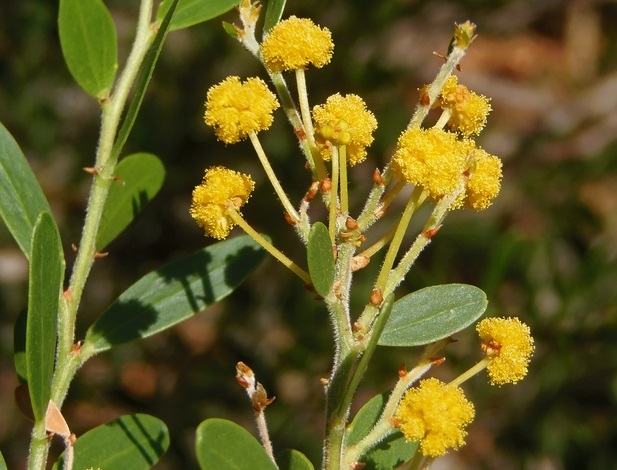Created by: Elizabeth D. Brusati
Created on: Monday, Jan 25th, 2016
Created on: Monday, Jan 25th, 2016
Yes or No:
Yes
Points:
1
Confidence Level:
Very High
Answer / Justification:
South Africa, Ethiopia, California, Portugal
Reference(s):
Yes or No:
Yes
Points:
2
Confidence Level:
Very High
Answer / Justification:
Naturalized in 6 counties in California.
Reference(s):
Yes or No:
Yes
Points:
2
Confidence Level:
Very High
Answer / Justification:
Invasive in South Africa, where it occurs in the Cape Coastal area, also in the mountain and lowland fynbos, and southern and eastern Karoo.
Reference(s):
Yes or No:
Yes
Points:
3
Confidence Level:
High
Answer / Justification:
Invasive in South Africa, where it occurs in the Cape Coastal area, also in the mountain and lowland fynbos, and southern and eastern Karoo. These areas match California based on Cal-IPC's climate map.
Reference(s):
Yes or No:
Yes
Points:
1
Confidence Level:
Very High
Answer / Justification:
Acacia dealbata and A. melanoxylon are invasive in California.
Reference(s):
Yes or No:
Yes
Points:
2
Confidence Level:
High
Answer / Justification:
Native to winter rainfall areas of W. Australia. Also grows in winter rainfall areas of South Africa. Naturalized in Portugal. These areas match California. Map from Australian herbarium shows it on the coast of South Australia and Victoria, which match California.
Reference(s):
Yes or No:
Yes
Points:
1
Confidence Level:
Very High
Answer / Justification:
forms dense, impenetrable stands that shade out native vegetation
Reference(s):
Yes or No:
No
Points:
0
Confidence Level:
Medium
Answer / Justification:
Seed germination enhanced after fire but rarely regrows after fire damage.
Reference(s):
Yes or No:
No
Points:
0
Confidence Level:
High
Answer / Justification:
No mention of toxicity. It is planted as a food for goats and other livestock. No evidence available on its impact to grazing systems.
Reference(s):
Yes or No:
Yes
Points:
1
Confidence Level:
High
Answer / Justification:
Forms dense, impenetrable stands that shade out native vegetation in the lower fynbos of South Africa, where intertwined crowns block native vegetation. Grows 1-2m in its first two years. Grows to 3m, in some areas as tall as 8m.
Reference(s):
Yes or No:
No
Points:
0
Confidence Level:
Medium
Answer / Justification:
Rarely coppices but "will not coppice after a good burning or an effective chopping-down."
Reference(s):
Yes or No:
No
Points:
0
Confidence Level:
High
Answer / Justification:
Doesn't seem likely given that it's a shrub/tree
Reference(s):
Yes or No:
Yes
Points:
1
Confidence Level:
Very High
Answer / Justification:
Reproduces from seed. Seeds are dark brown to black, compressed, surrounded by a fleshy fruit.
Reference(s):
Yes or No:
Points:
Confidence Level:
Very Low
Answer / Justification:
Produces "large quantities of seed" but no specific number so I am leaving blank
Reference(s):
Yes or No:
No
Points:
0
Confidence Level:
High
Answer / Justification:
A study by Shanta, et al 2005 indicates that normally germination occurs just below 20% and that scarification or heat or some other factor is required in order to improve germination significantly.
Reference(s):
Yes or No:
Points:
Confidence Level:
Answer / Justification:
Could not find information
Reference(s):
Yes or No:
Yes
Points:
1
Confidence Level:
Medium
Answer / Justification:
In native Australia, flowers Sept. - March and seedpods mature in Jan. and Feb. In South Africa, flowers Oct-Feb and sporadically throughout the year. Jespon eFlora indicates it flowers in California from December to March, so answered Yes based on this information.
Reference(s):
Yes or No:
Yes
Points:
1
Confidence Level:
Very High
Answer / Justification:
Dispersed by birds and mammals (including small rodents, baboons, doves, starlings). Birds like to eat the seed stalks.
Reference(s):
Yes or No:
No
Points:
0
Confidence Level:
Medium
Answer / Justification:
No mention of this in references. Animals appear to be the main form of dispersal.
Reference(s):
Yes or No:
Yes
Points:
1
Confidence Level:
High
Answer / Justification:
In South Africa, dispersed by human activities for long distances. No specific information on exactly what spreads it.
Reference(s):
Direct link to CABI datasheet:http://www.cabi.org/isc/datasheet/2197. Version "last modified October 21, 2015."
Jepson eFlora link: http://ucjeps.berkeley.edu/eflora/eflora_display.php?tid=11632
Reviewed by Barb Castro and Ron Vanderhoff.
- < 13 : accept (low risk of invasiveness)
- 13 - 15 : evaluate further
- > 15 : reject (high risk of invasiveness)
PRE Score:
17
Number of questions answered:
18
Screener Confidence (%):
83.3
Organization:
Evaluation visibility:
Public - accessible to all site users

